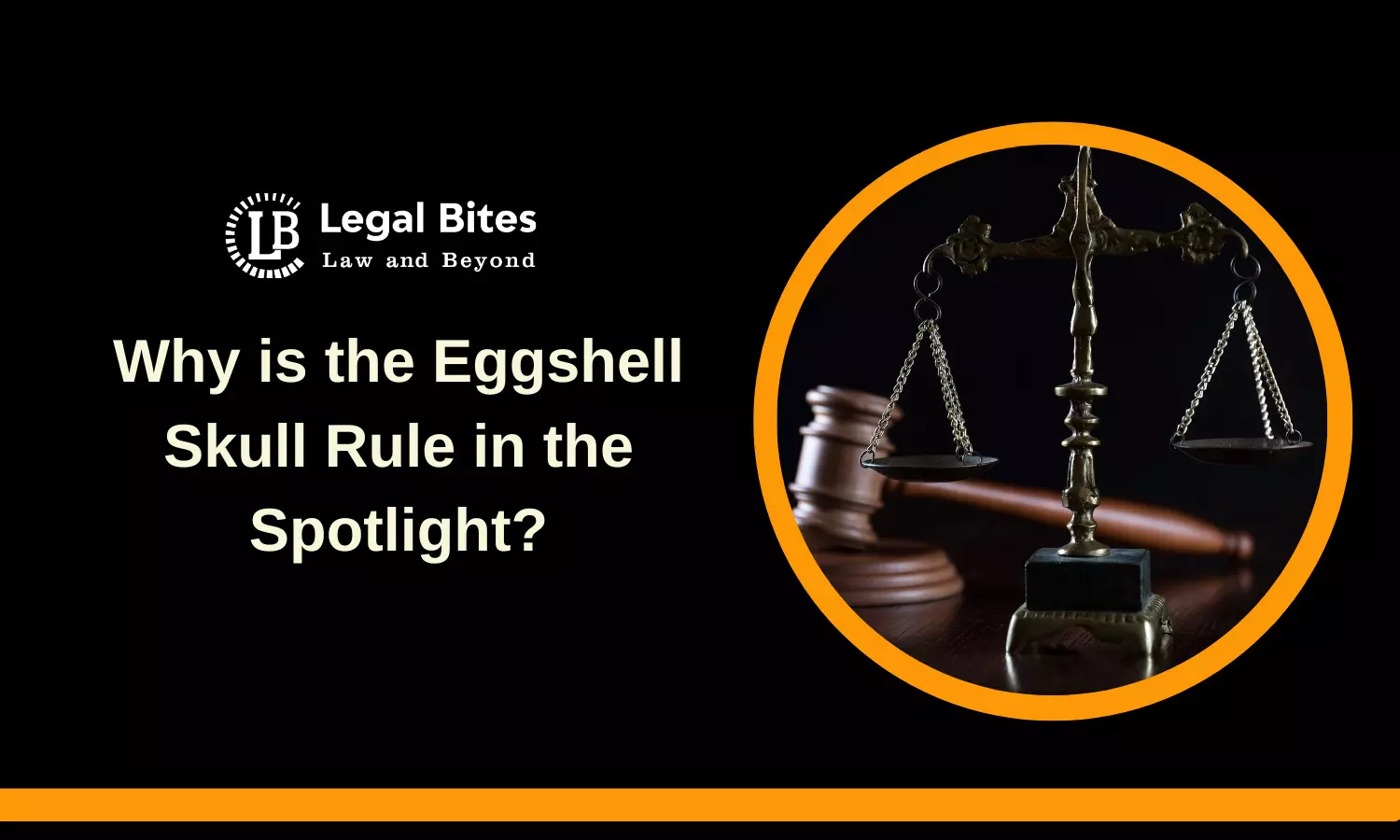Why is the Eggshell Skull Rule in the Spotlight?
Eggshell Skull Rule has come under the spotlight in light of prominent cases and evolving discussions about accountability and justice in the legal system.

The Eggshell Skull Rule dictates that a defendant must take responsibility for all damages caused by their actions, even if the victim has a pre-existing vulnerability or condition that makes them more susceptible to harm.
Eggshell Skull Rule: Jyoti Devi v. Suket Hospital And Ors.
On June 28, 2005, Jyoti underwent an appendectomy at a hospital-based in Mandi, Himachal Pradesh, where the doctor successfully removed her appendicitis, but unfortunately, her recovery course wasn’t at all smooth. Jyoti and her family endured a roller-coaster ride as she continued to suffer the brunt of persistent pain near the surgical side even after the so-called successful surgery. Subsequently, the hospital readmitted her for further medical intervention and evaluation, only to discharge her again the following day with the assurance that the pain would cease to exist. She tenaciously sought further medical attention from another doctor after the initial referral.
However, the excruciating pain remained undeterred for a protracted four years. Finally, she compelled herself to undergo a diagnostic evaluation at the PGI in Chandigarh. Therein, a meticulous investigation unveiled a foreign body, a 2.5-cm needle present below the anterior abdominal wall in the preside region just medial to the previous abdominal scar, and thus necessitated prompt surgical intervention for its extraction from therein.
Consequently, she initiated legal proceedings against the hospital by filing a consumer complaint with the District Consumer Redressal Forum. In a clear verdict, the district forum acknowledged the hospital's negligence, which had inflicted more than five years of pain on the patient, and they awarded her a compensation of Rs. 5 lakh as a consequence of the same. Aggrieved by the decision of the district forum, the respondent appealed to the Himachal Pradesh State Consumer Disputes Redressal Commission, and the commission reduced the amount of compensation to a mere Rs. 1 lakh despite acknowledging the hospital's fault.
She, however, remained undeterred and contested the case with the National Consumer Dispute Redressal Commission, and the Commission, wielding the eggshell rule, nudged the compensation amount to Rs. 2 lakh. Yet, not satisfied, she tenaciously pursued healthcare justice by escalating the case to the Supreme Court.
The division bench, comprised of Justices Sanjay Karol and Aravind Kumar, recently delivered in Jyoti Devi v. Suket Hospital And Ors., Arising out of Special Leave Petition (C) No.242 of 2016, a scathing judgement, explicitly rejecting the ratio decidendi of the National and State Consumer Forums and therefore vindicating the original award of the District Forum. The Court's decision hinged on the hospital's egregious medical negligence in the surgical case and their utter silence regarding the cause of her persistent post-surgical pain for many years. This underscores a grim picture of a healthcare system in desperate need of attention and reform. The court further asserted that the rule of eggshell is only applicable in cases involving pre-existing conditions.
What is the Eggshell Skull Rule?
The eggshell-skull rule, commonly known as the thin-skull rule, is a common law doctrine based on the legal maxim “take your victim as you find him.” Even if the victim's pre-existing vulnerability exacerbates the harm or injury beyond what an ordinary person would experience or suffer, the wrongdoer remains completely liable for the inflicted harm or damage, and the liability extends and persists even if the doer was completely unaware of the victim’s condition.
To put it simply, the victim with exceptional fragility bears a disproportionately severe consequence from an act or conduct that a person of typical resilience would weather unscathed. The expression “eggshell” comes from the metaphor of a person with a skull as fragile as an eggshell. A victim with a fragile skull is at risk of sustaining serious damage or injury even from a minor act, whereas a person with a regular skull may not experience any harm at all.
The rule, therefore, recognises the fact that people have different pre-existing conditions or may be prone to different vulnerabilities, and the doer is liable for any damage or injury he or she may cause to the victim, irrespective of those conditions and vulnerabilities. To some extent, the rule shifts the burden of proof from the victim to the doer. Over the years, the courts have extended the tentacles of this rule to medical negligence cases, including emotional and psychological across various jurisdictions.
What is the origin of this rule?
The eggshell skull rule is not alien to the medico-legal fraternity. The common law sows the seed of this rule. The 19th century saw the English and American courts actively lay the foundation for the rule. The term ‘thin rule’, for the first time, emerged in the English case of Dulieu v. White & Sons. (1901), 2 KB 669. The courts, however, limited the defendant's liability solely to physical harm. As the courts attempted to modify the application of the rule over a while, they extended its application to cases of mental harm and economic injury as well.
The locus classicus case, Vosburg v. Putney, [50 N.W. 403 (Wis. 1891)], enunciated the rule. In that case, in an altercation, Putney, a child in the school, kicked another child, namely Vosburg, in the shin in the classroom, and Vosburg had injured his leg in a sledging accident a month before this act. As a result, the act of Putney aggravated the previous injury and resulted in activating a grumbling infection, which eventually led to an amputation, thereby causing permanent incapacitation.
The court found the wrongdoer liable for all the injuries, regardless of Vosburg’s condition. The courts in other states also began to apply this rule and have retained it till now. To name just a few: The Alabama Court in the case of Montgomery & E. Ry. Co. v. Mallette (Ala. 1891) found the defendant liable for further aggravating the plaintiff's injury; likewise, the Minnesota Court in the case of Keegan v. Minneapolis & St. Louis R.R. Co., (1899) 76 Minn. 90, 78 N.W. 965, found the defendant liable despite its inability to foresee the pre-existing conditions. The courts soon evolved it into a doctrine and formulated several exceptions to this rule to award damages in all cases of pre-existing conditions.
In what specific categories does the rule typically apply?
There are four types of categories in which the court can typically apply the rule. First, the court can only invoke the rule when defendants discover the plaintiffs’ latent conditions. To substantiate this point further, for instance, in the case of Hammerstein v. Jean Development West, 111 Nev. 1471,907 P.2d 975, the plaintiff, a diabetic patient, suffered a sprained ankle during a hotel evacuation due to the defendant’s negligence in maintaining an alarm system.
Due to the plaintiff's pre-existing diabetic condition, the sprain escalated into a gangrene infection, and thus, the court applied the rule. Second, when the negligence on the part of the defendant precipitates a resurgence of previously successfully stabilised pre-existing conditions through medical treatment. For example, in the case of Elizabeth Bruneau v. Richard F. Quick, 447 A.2d 742, 187 Conn. 617, the defendant's surgical intervention on the plaintiff’s feet demonstrably exacerbated a pre-existing condition. The defendant, however, contended that his intervention did not actively exacerbate an unknown pre-existing condition.
The court, consequently, applied the rule and held the defendant directly liable for the injuries sustained. Third, the court applies the rule when negligence on the part of the wrongdoer aggravates the known pre-existing conditions that have not yet received adequate medical treatment. In Glamann v. Kirk, 29 P.3d 255, 261 (Alaska 2001), for instance, a car travelling at high speed struck a truck from behind, resulting in the latter's violent hyperextension of the cervical vertebrae. To mitigate the culpability, the defendant contended that the plaintiff’s headache originated from a previously fractured jaw other than a prior car accident.
The court, however, dismissed the argument and held the defendant fully liable for incurred trauma. Fourth, the rule further applies to cases where a wrongdoer's actions accelerate the deterioration of a plaintiff's pre-existing condition and, as a result, directly cause disability or loss of the plaintiff's life, and the defendant is still liable for his or her actions, even if the eventual outcome wouldn't have occurred absent the defendant’s negligent conduct.
The case of McCahill v. New York Transportation Co., 94 N.E. 616, 617-18 (N.Y. 1911), demonstrates an example of this category. In that case, the defendant’s employee negligently collided a car with the plaintiff while negligently driving a taxi, who was suffering from alcoholism. As a result, the plaintiff sustained multiple fractures and subsequently succumbed to a medical condition associated with alcoholism. Despite the likelihood that the plaintiff's alcoholism would have ultimately culminated in his premature demise, the court upheld the award of additional damages.
How do courts in India reconcile the rule with the evolving standard of medical practices?
The courts in India have walked a tightrope, instead selectively applying and relying on the rule exclusively in light of the dynamic landscape of medical practices. It may be because of intricate factors associated with human health or a lack of uniformity in deciding on medical suits. The judiciary has sole discretion when resolving complex and technical medical cases. The test for determining the existence of a standard of care has changed. The medical cases, therefore, about compensation and liability demonstrate a complex interplay of positive and negative implications.
In the case of Judeba Kom Moulasab v. Kansoor Group, 1980 SCC Kar 32 (Division Bench), a pre-existing pneumonia exacerbated the claimant's husband's accidental injuries, ultimately causing his death. Consequently, the court granted the claimant compensation. In another case, the Punjab and Haryana High Court, in the case of National Insurance Company Limited v. Pooja Verma, (2010) dismissed the insurance company's appeal and enhanced the compensation to the widow of the deceased. The court reasoned that even in a case where the deceased had a propensity for ill health, the accident precipitated the death.
The courts in India have also invoked the said rule for the enforcement of fundamental rights such as the right to health and a pollution-free environment under Article 21 of the Constitution of India. For instance, in Jaipur Golden Gas Victims Association v. Union of India, 2009 SCC Del 3357 (Division Bench), the respondent possessed a godown where they stored a consignment of rodent-killing pesticides. Unfortunately, the fire broke out in the godown, prompting the firefighters to douse it with water.
The Act, consequently, triggered a chemical reaction in the godown, releasing a highly toxic gas called phosphine. Around 35 individuals in the vicinity fell ill due to exposure to this gas. Two of the claimants, who were already suffering from tuberculosis, passed away within a week of the accident. The court held the respondent liable to pay compensation for this act. In cases of personal injury, the courts generally take a broad view of the question of damage, injury, loss, or degree of foreseeability. The courts, therefore, haven’t tried to extend the tentacles of said rule beyond the healthcare insurance case laws. The application of the rule is intricate and debatable, which requires elaborate and comprehensive treatment at the conceptual level during the application of the judicial mind.
References
[1] EggShell Economics: A Revolutionary Approach to the Eggshell Plaintiff Rule, Available Here
[2] Measure of Damages--Aggravation of Previous Injury, Disease, Disability or Latent Weakness, Available Here

